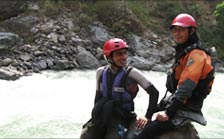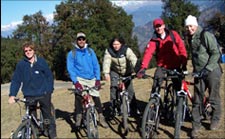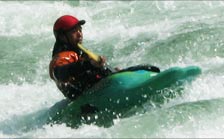Buying the right kayak paddle is an often overlooked task for beginners. All too often, the choice becomes one by default. We spend a lot of time looking at kayaks, sitting in them, and adjusting the fit. We buy the helmet based on feel and, let's not kid ourselves, by what looks cool. But then it comes to selecting a paddle. And what do we do? We just buy the paddle that the salesman gives us. Or we just buy the cheapest one they have.
Rarely do we ever worry about size, weight, construction, materials, feather, or blade symmetry. Admittedly, some of those things really don't matter to a beginner and won't benefit the paddling they do starting off. But I can't tell you how many times I have seen a new kayaker come home with a paddle that is simply too long for them. Whether you will be buying your first paddle or you are considering an upgrade, this article will outline all of the features that you may want to consider.
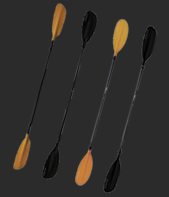
Paddle Shaft
The shaft is the part of the paddle that you place your hands on. Most people don't realize that there is actually a lot that goes into designing a paddle shaft.
Shaft Type: Straight or Bent Shaft. Straight shafts are more common, lighter, and cheaper. Bent Shaft paddles put less stress on your joints, promote proper stroke alignment, and are more comfortable.
Shaft Size: Most people don't know that there are different shaft diameters. As hand size increases so does the thickness of the needed paddle shaft. The choice here is primarily based primarily on comfort. Here is a "handy" hand sizing chart to guide your decision.
Paddle Blade
The blade is the part of the paddle that enters the water and propels the boat. Similar to the paddle shaft, the design features related to the paddle blade are important.
Blade Shape: Symmetrical or Assymetrical. An assymetrical shape provides for a smooth entry into the water. A symmetrically shaped blade is able to be paddled with either hand since the blades are exactly the same on both sides.
Feather: The feather of a paddle refers to the angle that each blade is offset from each other. The feather of one blade to another is usually measured in 15 degree increments with the most common being a 45 degree feather.
Construction
Blade and Shaft Materials: There are many materials that paddles are made from such as: aluminum, plastic, carbon, fiberglass, reinforced nylon. The materials determine the weight, durability, performance, and ultimately the price of the paddle.
Detailed Information: Here is a paddle construction guide that will help you with more of these details.
People typically buy kayak helmets based on style. Once upon a time there was only one type of whitewater helmet and it was plastic. The only decision to be made was which color best helped you to express yourself. Those days are over now. Nowadays kayak helmets are made of a variety of different materials with styles that make you feel cool just wearing them. This guide will help you navigate your way through the world of setting out to choose and buy a whitewater kayak helmet. Anatomy of a Kayak Helmet A kayak helmet contains three main parts. The shell is the hard outer portion of the kayak helmet. The lining refers to the foam inside of the kayak helmet that contacts the head. Lastly the strap system keeps the helmet secured to the paddler's head.
Whitewater Kayak Helmet Types
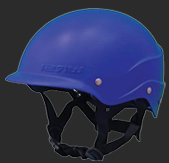
While the outer look and style of a kayak helmet might vary, there are only two basic types of helmets. There are full-cut kayak helmets and there are half-cut or above the ear helmets. Full-cut kayak helmets include outer shell ear protection. As the helmet comes down over the ear of a full-cut helmet, by extension it also offers better protection of the temple area of the head. Half-cut helmets don't cover the ears of the paddler. They are generally more comfortable and looser fitting than full-cut helmets. Half-cut whitewater kayak helmets have become the norm nowadays.
Kayak Helmet Materials
When considering the materials of a whitewater kayak helmet the paddler should first determine the type of shell they want and then find the helmet made from that material with the most comfortable liner. The hardest and strongest whitewater kayak helmet shells are made from carbon fiber, Kevlar, and composite polymers. Plastic helmets are the lowest strength helmets although they are well proven, having been used for decades in whitewater.
Properly Sizing and Putting on a Kayak Helmet
A kayak helmet should fit both securely and comfortably on the kayakers head. It should not be so tight that it hurts or gives the wearer a headache. On the other hand, the kayak helmet should not be so loose that it can be pushed or pulled off of the paddlers head. Basically, the inner liner should be slightly depressed and there should be no gap between the lining and the paddlers head while it is being worn.
Question: What Equipment Do I Need to Start Kayaking?
Getting into any sport can be an expensive affair. That is exactly why many beginners want to know what equipment they must have to get started. Below you will find an explanation of the essential gear that a kayaker must have as well as other non-essential equipment you may want to consider purchasing.
Essential Kayaking Equipment

Kayak: Whitewater kayaks are completely different from Sea or Touring kayaks. The type of kayak you choose depends completely on what type of paddling you wish to do and what level of paddler you are.
Paddle: Each type of kayaking uses a different type of paddle. The store where you buy your equipment can help you figure out which paddle goes with the kayak you decide to buy.
PFD: PFD stands for Personal Flotation Device and is essentially a life jacket or life preserver for kayakers.
Spray Skirt: Spray skirts help keep the water out of the kayak. They are necessary for Whitewater and Sea Kayaking. Recreational kayaking can do without them. You must be sure that the skirt fits both you and the kayak.
Helmet: Helmets are a requirement for Whitewater Kayaking. They are not a requirement for Sea Kayaking. I always recommend using a helmet while Surf Kayaking.
Non-essential Kayaking Equipment
Dry Top, Drysuit, Wetsuit, Paddle Jacket: This is totally a matter of preference and water temperature. Some people always use a dry top. Others paddle without any of these items all summer long.
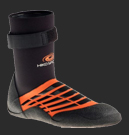
Booties: Make sure they are comfortable and that you fit into the kayak while wearing them.
Gloves: This is also a matter of preference as some people hate to paddle with gloves. In addition to keeping your hands warm, gloves also protect your knuckles from scrapes and gashes.
Rope Bag: It could help you save the life of a friend. I strongly recommend all paddlers to carry a rope bag.
Knife: This is one of those items you will probably never use. In the event you get tangled in a rope or stuck under a raft, you'll be glad that you had one.
Float Bags: These bags that fit in the stern of the kayak will keep it from sinking should you get separated from your boat.
Dry Bag: This will keep your snacks and camera dry. Just make sure it is attached inside of the boat.
Kayak Gear Storage
Nothing is worse than getting out on the water and finding out that some item you're wearing is ripped or broken. Also, canoe and kayak gear isn't cheap. It is for these reasons that proper storage of your canoe and kayak gear is crucial. We should take every step we can to make sure that we can get as much life out of our gloves, booties, paddling jackets, pfds, and whatever we paddle with as we can. Here is a list of 5 things you can do while packing up your stuff to help extend the life of your gear.
Make Sure it is Dry
This is common sense but every paddler knows that it doesn't always happen. The story goes like this. You spend a day paddling with your buddies, then throw your gear in a tub and start the long drive home. You may even stop for a bite to eat and some reminiscing. By the time you get home its dark out and you're too tired to unpack your canoe or kayak gear. Then the work week starts and it gets forgotten and the proper storage of your canoe and kayak gear is left to the wayside. Do yourself a favor and take the first 10 minutes when you get home and hang up your gear so that it dries for storage. Then, while it is all out and organized inspect each item so you know what you're dealing with before storing it away.
Repair and Preserve Your Gear
Having a paddling gear repair kit is a big help with this step. Once your gear is dry, keep out the items that need some preservation or repair. This step is most often overlooked. Rubber items such as the gaskets on a dry top or the o-rings on dry boxes should be treated with 303 Protectant. Zippers of jackets and bags should be lubricated, especially if they were used in salt water. Repair any neoprene damage with Aqua Seal. And of course use our beloved duct tape on everything else!
Keep Everything Together
It is true, this is common sense also. But we all know someone who has gotten to the water and realized that they were missing a glove, a bootie, or something more important like a pfd. Once your gear is dry, store everything you need in ONE Rubbermaid or large duffel bag. If you're like most paddlers you'll have more gear than can fit into just one of anything. That's ok because you probably only use the same main stuff and the rest is extra gear. Keep your main gear in one container and the rest in another.
Store in a Dry Place
Yes it is true, there is no point to making sure everything is dry if you are only going to leave your stuff outside, under your deck, or in a damp place in your basement. Paddling Jackets especially don't hold up well to being kept in a damp place due to all the loose fabric bunching up and being a breeding ground for mold and mildew. Neoprene will develop an odor that you just can't seem to get rid of under these conditions. Find a storage area that will keep your canoe and kayak gear dry and well protected.
Store Your Boat
Canoe and kayak storage is definitly overlooked. They are usually just thrown in the most convenient place a the time. Whenever possible, canoes and kayaks should be hung by straps from the ceiling. This is because plastic kayaks can get deformed from the prolonged pressure of being on the ground or up against something hard. If you can't hang up your boat(s) then lean them on their side so the boat doesn't develop a flat spot on the bottom of the hull. If you don't paddle for a while, be sure to flip the canoe or kayak over to the other side every so often.
Planning an overnight canoe or kayak trip can often be as much fun as the trip itself. A properly planned trip involves research, conversation, and packing. Ensuring you are properly packed before you leave on your combination paddling-camping trip is crucial. Nothing is more frustrating than getting to your destination only to realize you have forgotten an important implement needed on the trip. That's why a overnight canoe trip checklist can be the difference between being fully prepared or forgetting something that is important to your paddling trip.
I have composed here a list of all the items that could be taken on a camping and canoeing trip. The items in this list are separated into camping, clothing, canoe or kayak, food, and recreational items. I have also attempted to give a brief explanation for each item which may help you in deciding whether or not you will need it on your specific trip.
Camping Equipment to Bring on a Paddling Trip
Figure on bringing whatever camping gear you normally bring on camping trips. Keep in mind you will have space constraints as everything will need to fit in your canoe or kayak. Be sure to keep things dry by using dry bags, garbage bags, zip locks, and dry boxes.
 Tent: Be sure it packs down to a manageable size to fit in your canoe or kayak.
Tent: Be sure it packs down to a manageable size to fit in your canoe or kayak.Sleeping bag: The sleeping bag should be chosen based on the weather conditions.
Sleeping Pad: Bring a sleeping pad purely for comfort.
Camp Pillow: Bring a camp pillow purely for comfort.
Camp Chair: Camp chairs are not a necessity but if there's room t hey sure beat a log.
Flashlight: A headlamp is preferable to a flashlight. Multipurpose Knife with tools: I'd never go camping without one.
Thermal Safety Blanket: It's always good to be prepared.
Matches: Waterproof matches can be found any place camping gear is sold.
Lighter: Bring a lighter in addition to matches- one might fail.
Fire starter: Why kill yourself trying to make a fire?
Zip Lock Bags: Buy the kind that has a zipper. These will keep things dry.
Garbage Bags: These are the poor mans dry bags. Also use to throw away your trash.
Dry Storage Box: These boxes are great to keep cell phones and GPS units safe and dry.

Extra batteries: Bring extra batteries for every electronic device you have.
Cell Phone: Cell phones should be brought in case of emergency.
Backpack: Depending on where you are paddlin g, you may want to get out and hike.
Maps: Have good maps of the area. Compass: It would be a good idea to know how to use one also.
Water Purifier or Water Tablets: This is a backup to the water you'll be bringing.
Rope: Prevent wildlife from getting at your food by tying it up when you're sleeping.
Duct Tape: This implement really needs no explanation.
Paddling Gear to Bring on an Overnight Paddling Trip
Canoe or Kayak: It wouldn't be much of a paddling trip without a boat.
 Paddle: It's kind of obvious, I know.
Paddle: It's kind of obvious, I know.Spare Paddle: This is purely you preference, but you never know.
PFD: Lifejackets are needed for everyone in your party.
GPS: Know where you are, how far you've gone, and how to get to safety at all times.
Rope: You may need to tie your boat to shore at times.
Toiletries to Bring on an Overnight Canoe Trip
First Aid Kit: If you bring a prepackaged one, make sure it has everything you need.
Sun block: You can get burned even on an overcast day.
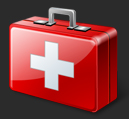 Chap Stick: Keep your lips healthy while on the water.
Chap Stick: Keep your lips healthy while on the water.Toilet Paper: Roll some up and put it in Ziploc baggies unless you'd rather use leaves.
Toiletry Bag: Fill it with whatever you personally need.
Clothing to Bring on an Overnight Canoe Trip
Be sure to pack clothes for the type of conditions you will be facing during the day, the night, and on the water. You will need to pack things so that they stay dry.
Shoes for water: You should have shoes or closed-toe sandals with good support.
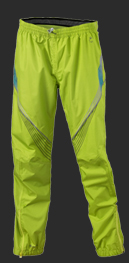 Bathing Suit: Bring a bathing suit to paddle in or to wear while swimming or bathing.
Bathing Suit: Bring a bathing suit to paddle in or to wear while swimming or bathing.Towel: Towels are needed not only for yourself but also to dry things off.
Sunglasses: Polarized sunglasses are great while on the water.
Hat: Keep the sun off of your face with a hat.
Wind Breaker: Even warm days can feel cool on the water. It should be waterproof.
Rain Pants: A rainy day can make for a miserable paddle.
Undergarments: Bring extra socks and underwear.
Non-Cotton Shirt: Polypropylene thermal wear is a good idea if the nights get cold.
Extra Pants or Shorts: It's always good to have a change of clothes when on the water.
Warm Clothes: Be sure to dress for the time of year and have clothes to sleep in.
Hiking Shoes: Good shoes are important for around the campsite or if you want to hike.
Cooking and Food Checklist for a Camping and Canoeing Trip
Cooler: Soft cooler bags are preferable to hard plastic coolers.
Ice Packs: These will only stay cool for the first day.
Stove: Unless you don't need to cook or heat up coffee.
Cookware: Determine what you need based on the items you'll be heating up.
2 Gallons of Water per person: Water is used for drinking and other things like brushing one's teeth.
Dry food Bars: Plenty of Power Bars, Boulder Bars, and Granola Bars will get you through the trip.
Meals: Plan enough food for every meal.
Recreational Equipment that Can be Brought on an Overnight Canoe Trip
Bring just about anything else you can think of to enhance your enjoyment of your surroundings and your trip.



